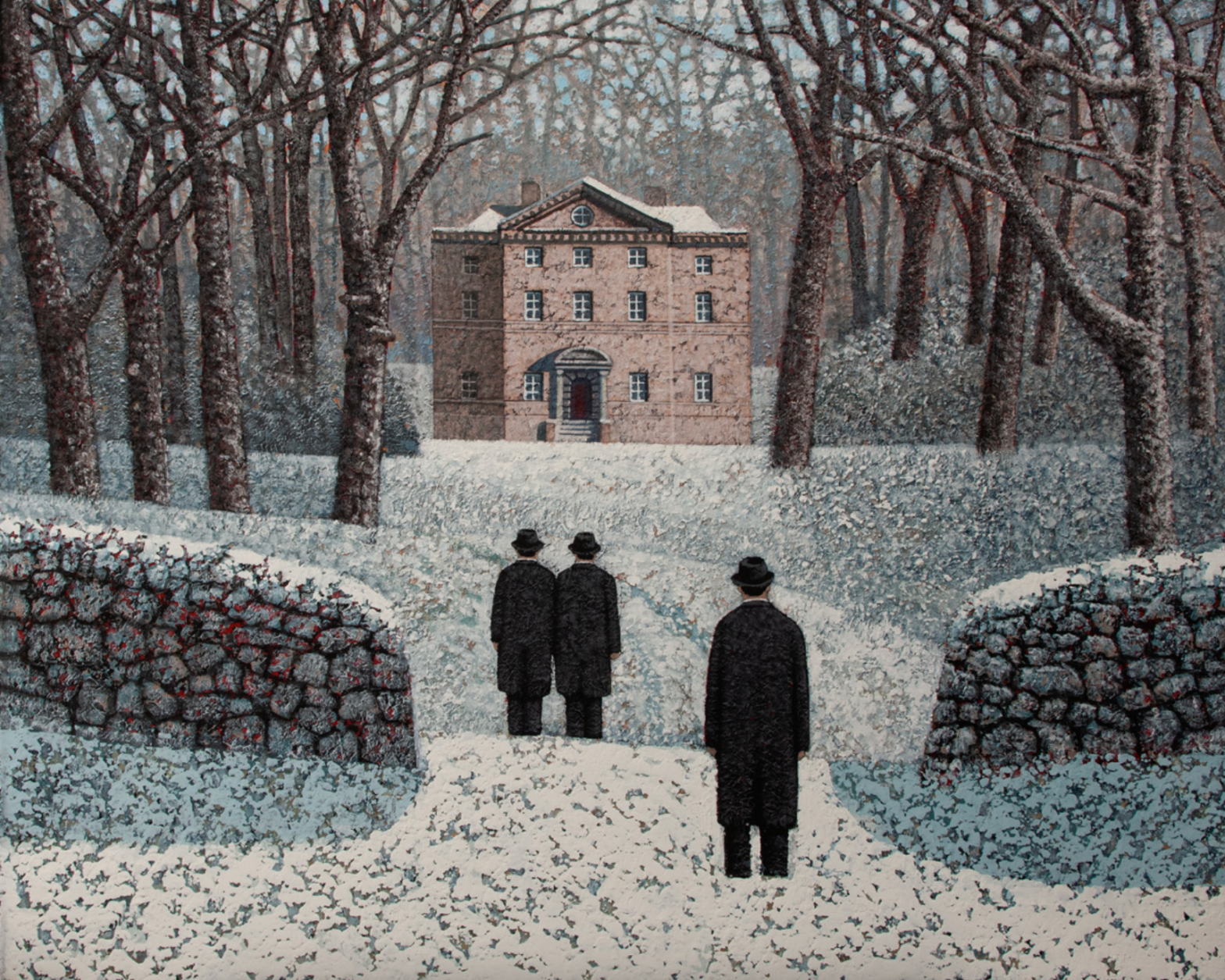One day, not long after Mark Edwards had completed his first collection of ‘white wood’ paintings, he got chatting to a tourist who was visiting Mark’s native Scotland. The visitor was a psychologist and he was very interested in the work. “The trees in your paintings…” said the psychologist. “They’re all dead aren’t they?”
The comment stunned Mark. He hadn’t intended the trees that way. But he had to concede the guy had a point. Perhaps they are all dead. And if they are, what does this mean?
Well, Mark certainly doesn’t know. Chat with the artist and it quickly becomes clear that he is not in the business of explaining his work. Not because it’s a secret. But because there is no explicit meaning. And maybe this is the secret of their success. The viewer can stand in front of the these intriguing little dramas and decide for themselves.
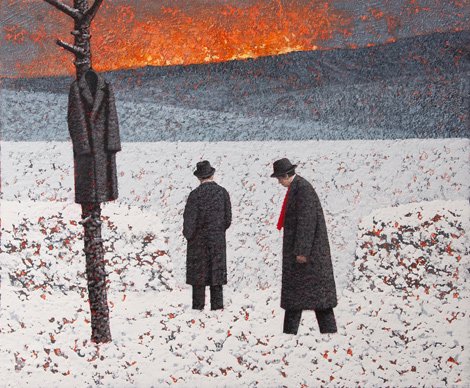


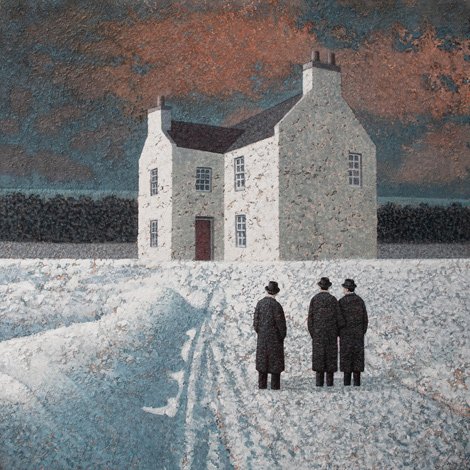
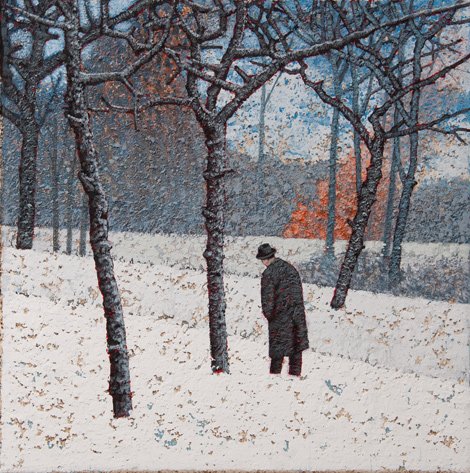

Why? Because the paintings are just the right side of oblique. The mysterious men in their overcoats and bowler hats are never at the centre of the drama. Instead, the action is taking place somewhere else: in that mysterious house or on the train that’s disappearing into the distance. The point is that the men are stuck here instead, in a kind of eternal limbo. And this limbo might even be self-imposed. Titles such as “Deciding not to go further” and ‘Stopping at the boundary” certainly suggest so.
As you can see, it’s possible to go very deep when you start thinking about Mark’s work. However, it should also be pointed out that the artist cares just as much about the composition as he does the ‘story’. Mark says he sees his figures – like his trees, houses and trains – as ‘pieces’ that can be moved around the canvas until the right effect is achieved. This explains in part why the men often look the same. “I’ve come to realise that I have this small repertory of about 10 men that reappear constantly in the paintings. I used to worry that this was a bit repetitive. But the postures just work. And anyway, they’re my paintings so I can do what I like!”
Mark started creating his ‘white wood’ paintings one day in 2007. He’d been painting since the 1970s at his remote home in the Scottish highland – so remote he had no mains electricity for many years. He was mostly depicting the deer stalkers on the nearby Duke of Westminster estate. He’d also earned a living as a book illustrator.
His change of direction was sparked when he saw a 1950s photo of James Dean on a New York street. In the background was a man in a bowler hat. It triggered something. Mark bought some hats and overcoats, and ventured into the woods with a few friends to try out some compositions. He had found a style that generated untold artistic possibilities. Happily, the public absolutely loved the work.
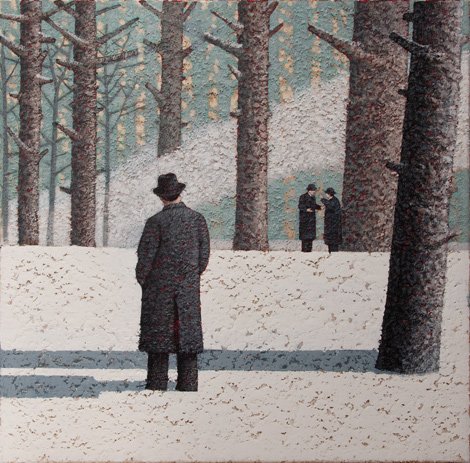
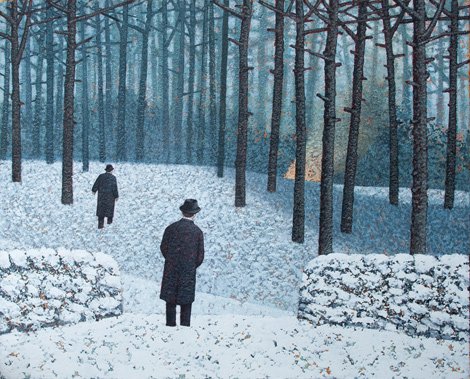
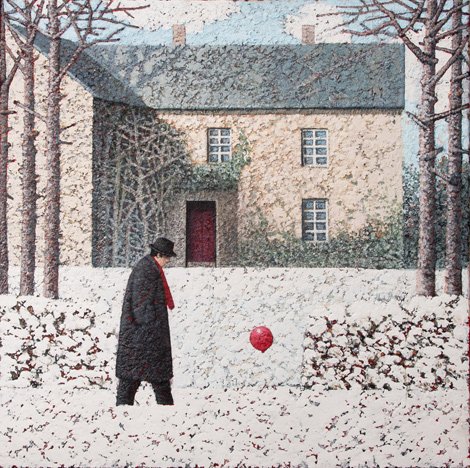
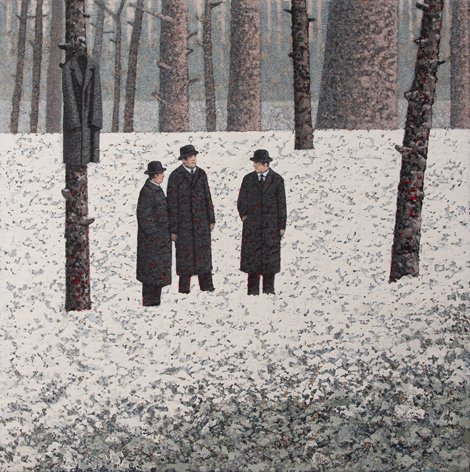
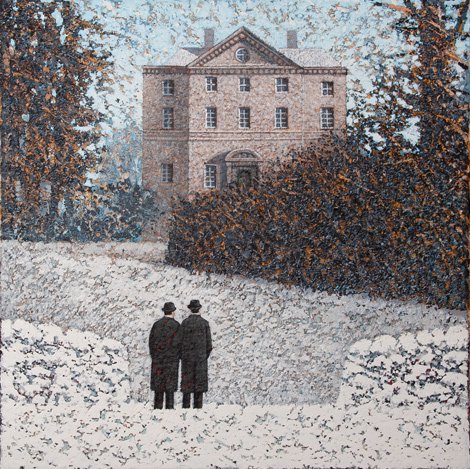

This new collection adds to Mark’s substantial repertoire. Although the themes are similar to what has gone before, Mark concedes that there is a slightly darker edge this time. “I’m aware that there’s an ominous quality to some of the paintings,” he says. “Maybe it’s the state of the world.”
Interestingly, this oppressive sense even surfaces in the physical quality of the works. “I found myself laying the paint on really thick this time. It was if I wanted the compositions to be literally heavy.” says Mark. “Anyway, if you buy one you will certainly get your money’s worth in terms of weight.”
Some of the most memorable moments in art take place ‘off screen’. For example, after two hours of unbearable tension, we never actually see what’s in the box in the movie Se7en. The power of this suggestive method is obvious: it asks the viewer’s imagination to fill in the gaps. And this is where the magic lives. As Claude Debussy said: “Music is in the space between the notes.”
Artist Mark Edwards knows this well. His ‘white wood’ paintings take place in a strange wintery inbetween-world populated by men in hats and coats. Though we rarely see their faces, we sense that these men are lost and a little desperate. And they appear to be pulled towards some invisible force that we can’t see.
The titles of the works bear this out: Waiting To Be Called, Unsure Of The Way In, The Last To Arrive. In these paintings, the men trudge, stare and debate. Sometimes they appear to be on their way somewhere. More often, they stand rooted to the spot as if mesmerised. In the distance we get hints of what might be diverting them. A passing train. A deserted house in the middle of the forest. A fire.
What does it all mean? Don’t ask Mark. He’s not getting involved. By his own admission, he doesn’t know. He just loves to move his pieces (men, coats, trees, houses) around until he achieves just the right level of ambiguity. Then it’s up to you.
Which painters do you admire and why?
There are too many to choose. But I love the work of Christopher Wood, Mary Newcomb and Hammershoi and I also get inspired by illustration.
Where else do you look for inspiration?
I like to browse YouTube for old British black and white films featuring bowler-hatted gentlemen. I’m always looking out for anything that could be added to the world of the white wood: an old grand house, a figure walking in a long coat and so on.
Do you paint every day? Are you disciplined?
I’m in my beloved studio every day from 9am to 7pm six days a week. If I can get away with it I might creep down on Sunday too.
How important is texture to the world you create in your work and how do you achieve it?
Very important, as it creates depth within the painting. By building up the various layers of colour I hope to exaggerate the surface of the finished painting. I’m usually aiming for random sand paper!
What is the most memorable thing anyone said about your work?
At one of my first shows a visitor came over and pointed to the painting of a man standing in the wood with his arms open and his face looking up at the sky. He told me with some certainty that the man works in a busy office, has travelled on a bus out of town, walked deep into the wood, raised his arms wide, then looked up to the sky and screamed.
What’s on fire?
I don’t know! But the flames give me an excuse to use red and suggest something else is happening in this dark wood.
Do you ever wear an overcoat and bowler hat?
I have three hats. I’m one of the men in the wood, so whenever we have heavy snow I’m out there with the camera.
Are the men dead?
Good question! I’d say no. But I can imagine some viewers might think they are.
The exhibition runs from 24th October – 11th November 2024 @ the Catto Gallery














